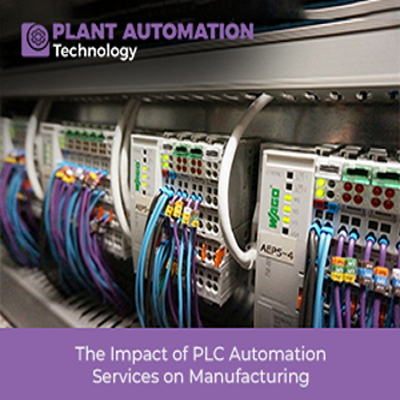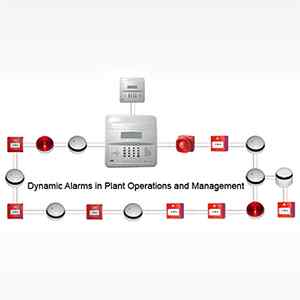The Impact of PLC Automation Services on Manufacturing

Introduction
Automation has emerged as a game-changer in today's fast-expanding production landscape, revolutionizing industries. Automation services for Programmable Logic Controllers (PLCs) are at the forefront of this transition. PLC automation services have grown in importance in manufacturing. They provide numerous advantages and advances in process control, efficiency, reliability, scalability, and adaptability.
Manufacturers in a variety of industries are embracing PLC automation services to optimize their operations and remain competitive in a volatile market. These services enable manufacturers to streamline their operations, boost production, and increase overall efficiency. This results in cost savings reduced downtime, and increased competitiveness by utilizing PLC technology. PLC automation services provide a wide range of solutions tailored to production operations' individual requirements. PLC automation services provide specialized solutions to address industry requirements. This is true whether it's optimizing assembly lines, improving quality control, or ensuring compliance with industry regulations.
One of the key elements of PLC automation is the Programmable Logic Controller itself. PLCs are specialized digital computers extensively used in industrial automation. They provide real-time control and monitoring capabilities, enabling manufacturers to regulate various variables, coordinate complex sequences of operations, and make data-driven decisions.
By implementing PLC automation services, manufacturers can improve process control and efficiency. PLCs enable real-time monitoring and adjustment of critical variables, ensuring optimal performance and minimizing waste. With precise control and automation of tasks, manufacturers can achieve increased efficiency, reduced cycle times, and enhanced product quality. Furthermore, PLC automation services contribute to decreased downtime and improved reliability in manufacturing operations. Through preventative maintenance strategies and remote troubleshooting capabilities, potential issues can be identified and resolved proactively, minimizing downtime and increasing overall equipment effectiveness.
PLC automation services offer scalability and flexibility in a rapidly changing manufacturing environment. As production demands evolve, manufacturers need the ability to adapt and expand their systems accordingly. PLC automation services allow for easy system expansion and integration with existing manufacturing infrastructure, ensuring agility and responsiveness to market changes.
PLC automation services have become a driving force in the manufacturing industry. They empower businesses to optimize their operations and achieve higher productivity, efficiency, and competitiveness. By harnessing PLC technology and leveraging tailored solutions, manufacturers can unlock automation's full potential. This will revolutionize their processes and pave the way for a more efficient and prosperous future.
| Also Read: Green PLCs: Sustainability and Energy Efficiency in the Fourth Industrial Revolution |
Understanding PLC Automation Services
PLC automation services encompass a comprehensive range of solutions designed to leverage PLC technology in manufacturing. A PLC is a specialized digital computer used in industrial automation to control machinery and processes. By employing PLC automation services, manufacturers can optimize their operations, improve productivity, and enhance overall efficiency. This results in cost savings reduced downtime, and increased market competitiveness.
What are PLC Automation Services?
PLC automation services entail the installation of PLC systems adapted to manufacturing operations' specific requirements. PLC design, installation, integration, programming, and maintenance are among the services offered. Manufacturers can guarantee that their PLC systems are optimized for optimal performance, reliability, and safety by utilizing automation professionals' experience.
The role of PLCs in manufacturing
PLCs are essential in modern manufacturing because they provide real-time control and monitoring. They are in charge of a variety of responsibilities, such as regulating temperature, supervising production lines, monitoring variables, and coordinating complex sequences of operations. PLCs provide accurate control, fast processing, and flexibility to adapt to changing manufacturing needs.
Key Features and Advantages of PLC Automation Services
PLC automation services offer several essential features and advantages that contribute to manufacturing operations transformation.
Enhancing Process Control and Efficiency
By integrating PLC automation services, manufacturers gain unparalleled control over their processes. PLCs enable real-time monitoring and adjustment of critical variables, ensuring optimal performance and minimizing waste. Through precise control and automation of tasks, manufacturers can achieve increased efficiency, reduced cycle times, and enhanced product quality.
Reduced downtime and improved reliability
PLC automation services focus on maintaining and improving manufacturing system reliability. By implementing preventative maintenance strategies and employing remote troubleshooting capabilities, potential issues can be identified and resolved proactively, minimizing downtime. This leads to increased overall equipment effectiveness (OEE) and improved production uptime.
Scalability and flexibility in manufacturing
Manufacturing processes often need to adapt to changing demands and market dynamics. PLC automation services facilitate scalability and flexibility by allowing easy system expansion and integration with existing manufacturing infrastructure. Manufacturers can introduce updated production lines, modify processes, and integrate additional equipment seamlessly, ensuring agility and responsiveness to market changes.
Implementing PLC Automation Services in Manufacturing
Successful implementation of PLC automation services requires a systematic approach involving assessment, system design, installation, integration, testing, and commissioning.
Assessment and system design
Prior to implementation, a thorough assessment of manufacturing processes is conducted to identify areas that can benefit from PLC automation. Based on the assessment, a system design is developed, taking into account factors such as process requirements, hardware selection, software programming, and communication protocols.
Installation and integration
In the installation phase of PLC automation services, essential hardware components such as controllers, input/output modules, and sensors are deployed. PLCs seamlessly integrate with existing industrial systems like supervisory control and data acquisition (SCADA) or human-machine interface (HMI). This integration ensures uninterrupted communication and efficient data interchange between the PLCs and the existing systems, enabling smooth and effective operation.
Testing and commissioning
Thorough testing and commissioning are vital to ensuring the functionality and performance of the implemented PLC automation system. This involves verifying control algorithms’ accuracy, testing interlocks, and safety features, and conducting simulations to validate system behavior. Rigorous testing minimizes the risk of errors or malfunctions and ensures that the system meets performance objectives.
Potential challenges in implementing PLC automation services
Implementing PLC automation services in the manufacturing industry comes with its own challenges. While the benefits are significant, it's essential to know and address potential obstacles to ensure a successful implementation. Here are some common challenges organizations may encounter when implementing PLC automation services:
1. Initial Investment: PLC automation services necessitate an initial investment in hardware, software, and automation professionals' experience. For smaller organizations or those with restricted funds, the upfront cost can be a substantial obstacle. However, it is critical to evaluate the long-term benefits and cost savings realized by improving efficiency and reducing downtime.
2. System Integration: Integrating PLC automation systems with existing manufacturing infrastructure, such as SCADA or HMI systems, can be complex. Ensuring seamless communication and data exchange between different systems may require additional configuration, programming, or even hardware upgrades. Proper planning and collaboration between automation specialists and IT teams are essential to overcome integration challenges.
3. Skilled workforce: PLC automation services require skilled professionals in programming, troubleshooting, and maintaining PLC systems. Finding and retaining qualified personnel who can effectively manage automation systems and address any issues that arise can be a challenge. Organizations may need to invest in training programs or outsource certain aspects of PLC automation to overcome this hurdle.
4. System Complexity: PLC automation systems can become quite complex, especially in large-scale manufacturing operations with numerous interconnected processes. Designing, programming, and maintaining complex automation systems requires careful planning and attention to detail. Clear documentation, standardized programming practices, and effective project management are crucial to system reliability and minimizing errors.
5. Resistance to Change: Implementing PLC automation services often involves significant changes to existing processes and workflows. Resistance to change from employees or stakeholders accustomed to traditional methods can hinder implementation. It's imperative to communicate automation benefits, provide adequate training, and involve employees in the transition. This will mitigate resistance and ensure smooth adoption.
6. Cybersecurity Risks: With the increasing connectivity of industrial systems, cybersecurity has emerged as a significant concern. PLC automation systems are vulnerable to cyber threats. A breach in security can lead to severe consequences, including data loss, production disruptions, and potential safety risks. To safeguard against these threats, it is crucial to establish robust security measures such as firewalls, intrusion detection systems, and regular system updates. By prioritizing cybersecurity, organizations can mitigate risks and ensure PLC automation systems’ integrity and resilience.
Addressing these challenges requires careful planning, collaboration, and expertise. Engaging with experienced automation professionals, conducting thorough risk assessments, and creating a roadmap for implementation can help organizations overcome these challenges. This will ensure the successful deployment of PLC automation services.
Conclusion
From streamlining assembly lines and improving quality control to enhancing production efficiency and ensuring compliance with regulations, PLC automation has proven to be a transformative force in the manufacturing industry.
By embracing PLC automation services, manufacturers can unlock numerous benefits, including increased process control, reduced downtime, improved reliability, scalability, and flexibility. These advantages enable businesses to achieve higher productivity, cost savings, and a competitive edge in the market.
As the manufacturing industry evolves, businesses must recognize the potential of PLC automation and leverage its capabilities. By partnering with experienced automation professionals, manufacturers can embark on a successful PLC automation journey. This will pave the way for a more efficient, productive, and prosperous future.







